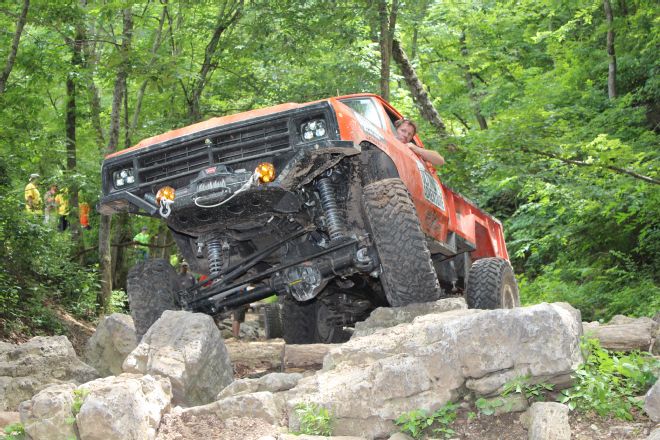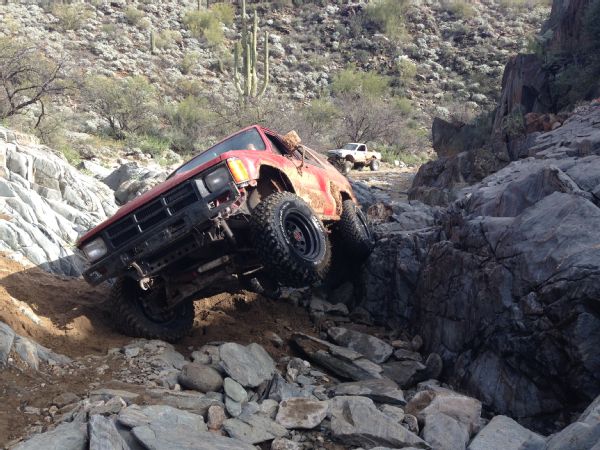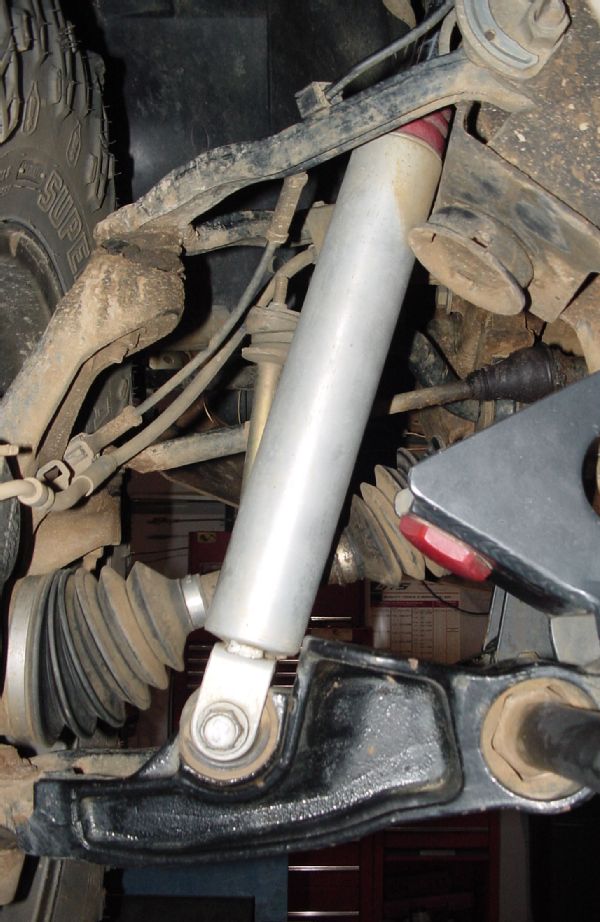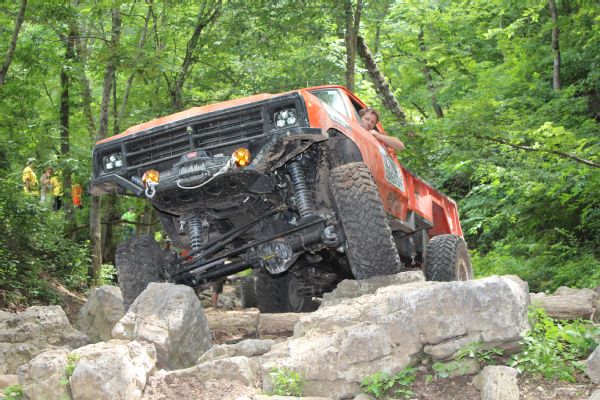
JK Squeaks Revisited
I just read the Nuts & Bolts email from Scott D. called “Squeaky JK” [May ’14]. He mentioned that his JK has an AEV lift and tire carrier. I have the same setup on my 2013 JK Rubicon unlimited. The persistent squeak that was also driving me nuts turned out to be the saddle block on the tire carrier. Two fixes: Adjust the turn buckle to ensure a tight fit (read the installation instructions for proper tension), and keep it clean and dust free. The block is a hard rubber or some other pliable material (not sure which), and I clean it with VinylX. After making two or three adjustments and keeping it clean, the squeak is gone.
Otto Rueger
Via nuts@4wheeloffroad.com
Duly noted! Not all squeaks that happen on bumps and rough roads come from the suspension. They often come from unlikely places, which is why it's hard to diagnose them by letter. Hopefully this helps out a fellow JK owner chasing the same squeaks.
Chevy TBI Upgrades
First off, let me say I've been a subscriber with you guys when you were Petersen's Pickup, Van and 4Wheel Drive and Bill Sanders was your editor. Anyway, this is my first time to write in on anything. I have a 1995 K2500 pickup that I purchased brand new and as it sits in my carport it has 108,576 miles on it. Besides my Harley, it's my baby. I'm looking to upgrade the engine and have about a $5,000-$6,000 budget. I would like to retain the 4L80 trans and 241 transfer case. I know that my truck's 5.7L is rated at 190 hp and 300 lb-ft of torque, so anything would be additional power. Looking at the GM performance catalog, I guess this series of trucks are bastards (1987-1995)? I would like to get 250 to 300 hp and 350 to 400 lb-ft of torque. I like the simplicity of fuel injection. My three main priorities are reliability, reliability, and mileage. I'm wanting to make the power from low rpm to midrange. Truck has 4.10 gears. I would like your input on where I should go. Thanks for the years of reading. You guys are the only truck /4-wheel publication I go to after doing Four Wheeler and Off-Road magazines plus whatever else is out there nowadays. Kudos!!
Paul
Via nuts@4wheeloffroad.com

Thank you for being a loyal reader all these years. While Chevy trucks of the mid ’90s are as reliable as a hammer, they don't exactly make gobs of power. I assume the truck is in good shape considering the relatively low miles and that you've owned it since new, so investing a little money on improving performance is wise.
According to my references, you are correct that your truck's small-block was rated from the factory at 190 hp and 300 lb-ft of torque, though the half-tons of the same year were rated slightly higher (210 hp) with the same torque. I'm going to base my suggestions on the assumption that the engine runs just fine and doesn't have any issues, because 108,000 miles is nothing for a small-block of that era as long as it has been properly maintained.
As I see it, there are two ways you can go. You can do some modifications to the engine that's already there, or you can swap it for a mild performance crate engine. If you have the mechanical knowhow and tools, there's no reason you couldn't reach your power goals with the current engine; modifying what you have will be less expensive but it will require some internal engine work. If you don't have the mechanical skills for internal engine work, then a crate engine might be the better choice.
Should you choose to stick with the engine you have, then I would recommend adding a good set of heads, a cam, an intake manifold, and headers. The stock camshaft profiles are very conservative, and the heads are notoriously restrictive. Replacing these with good-quality aftermarket heads and an RV camshaft will yield significant gains. Make sure you focus on a cam that improves horsepower and torque down low as opposed to a street-performance cam that improves power high in the rpm range. Combine heads and a cam with a good intake manifold and a quality set of headers, and you'll easily reach power levels in the range of 250 or more. If camshaft and head specs get a little fuzzy for you, companies like Edelbrock (edelbrock.com) have engineered power packages with components that were all designed to work together. We've used several products from the company’s Performer line in the past with great success on truck applications. The company even manufactures an intake manifold that your stock TBI system will bolt directly to, although you can also get adapters that will adapt standard or spread-bore carburetor mounts to your TBI (I would , however, recommend getting the proper intake manifold).
If that sounds like more work than you're willing to do or your truck's engine is wounded, then a crate engine is a great choice. There are all kinds of aftermarket crate engines out there, but it's hard to go wrong with one from GM Performance Parts (chevrolet.com/performance). Built with all new parts and backed by an excellent warranty, crate engines from GMPP meet just about every need and desire. For you, the 350/290 HP Deluxe engine is just about perfect. It has a sturdy four-bolt main block. All of your truck's engine accessories should bolt on. The only thing you will need is an adapter for bolting the throttle body to the intake manifold. The engine's price is actually well under your budget, leaving plenty of room for other upgrades. Right out of the box the Deluxe makes 100 more horsepower and 50 lb-ft of torque more than your stock engine, which is a major improvement.
One last thought as you contemplate your options: Keep in mind that the TBI system on your truck can only be built to support around 300 hp, which is one of the reasons why I suggested the 290hp Deluxe rather than GMPP’s H.O. 350 or other more powerful options. Once you get above 300 hp, you'll need to transition to either a carburetor or aftermarket fuel injection. It doesn't get much more simple or reliable than the TBI system that's already on your truck, and since reliability is a major priority, I recommend keeping it. Once you make your modifications, I strongly recommend taking it to a shop and making sure the air/fuel ratios are where they are supposed to be.
Three-Point-Slow
I could use your advice. I have a 1993 Toyota pickup 4X4 Xtra Cab with a 3.0L V-6 and a manual transmission. It has 165,000 miles, and it's a clean truck with no rust. I am the second owner, and I have owned it since 2000. About five months ago I brought it to the local Toyota dealer for a tune-up. Since then I have had nothing but engine problems. Every month the sparks plugs would go bad then the fuel injectors went out and now a head gasket. There are three good Toyota shops in the area, and none of them want to fix the engine. They talk me out of doing the work and say it's the worst engine Toyota ever made. $10,000 to rebuild the engine? No thanks! As much a mechanic as I am, a motor swap is out of my league. Now what? Sell it for parts? I'm not sure what to do. Any advice will help.
Joe
Via nuts@4wheeloffroad.com

I hate to be the bearer of bad news, but the shops you visited were giving you good advice. The 3.0L V-6 is one of the darkest points in Toyota history. It didn't make much more power than its contemporary four-cylinder, and it popped head gaskets with such alarming regularity that there was a recall. The good news is that Toyota gurus generally agree that once the head gasket issues are resolved, the 3.0L 3VZ is pretty bulletproof. It seems unlikely that your truck made it to 165,000 miles without being fixed at some point as part of the recall (and if by some miracle it was not fixed, I'm sure the recall has long since expired), so that means your engine is just succumbing to its age. I suspect your trip to the dealer for a tune-up just happened to coincide with the start of the problems, because nothing that is part of a regular tune-up could cause the chain reaction you've seen since then.
You face a difficult choice. On the one hand, you could rebuild the engine. I found several remanufactured long-blocks for $,2,500-$3,000, but these were only the block and heads. There's quite a bit of additional labor in installing the timing belt, timing cover, oil pan, engine accessories, and so on, let alone installing the engine in the vehicle. If this is beyond your mechanical experience level, it's likely that you would have to pay someone more than the truck is worth to get it back on the road. Even then, you would have something that moves under its own power but can barely get out of its own way. On the other hand, swapping the engine for a later 3.4L or a Chevy 4.3L V-6 would also involve a lot of money and expense, not to mention even more mechanical knowhow than installing a rebuilt engine.
If neither of these options sounds appealing, then it might be best to cut your losses and sell the truck not running. It will be worth a fraction of what it would be if it were a driver, but if it's in decent shape you should be able to get enough to put toward a newer Toyota with a much better and more reliable engine.
Gas or Hydraulic?
I recently purchased new Wrangler Duratrac tires for my Silverado 2500HD 4x4. I also bought the best set of Monroe gas-filled shocks that my local parts retailer chain had. I am very happy with the quality of both products. Which is better, gas or hydraulic shocks? Every auto parts store has given me a different answer. This is my daily driver and camping vehicle as well. It spends most of its time in the Great Lakes region. I appreciate your time and enjoy the mag.
Ranger
Via nuts@4wheeloffroad.com

For an everyday driver and weekend wheeler, either type of shock is just fine. In 95 percent of the driving conditions you will encounter, you would probably notice little, if any, difference if you had installed good-quality conventional hydraulic shocks on your truck instead of gas-filled ones. How a shock absorber works is more than we have the space to cover here, but there are some excellent articles about how shocks work available on our supersite, the Four Wheeler Network, such as this one: fourwheeler.com/how-to/suspension-brakes/129-1001-off-road-shock-absorbers-101/.
The only real difference between hydraulic shocks and gas shocks is that the latter has a pressurized gas charge inside of it (this is a bit of an oversimplification because there are several nuances among different shock manufacturers). Why? Friction is created as a shock piston moves through the hydraulic oil inside a shock body, and this friction creates heat. As the oil heats up, it has a tendency to aerate or foam, which is a fancy way of saying that air mixes with the oil. Air passes through the valves in the shock piston much faster than oil, which reduces the effectiveness of the shock to control suspension movement. This is referred to as shock fade. Pressurizing the fluid in the shock absorber reduces the tendency for the oil to foam, so a gas shock will perform better and longer in a really bumpy environment where the suspension has to work hard, such as when bombing down a fire road. But during everyday driving like taking the kids to school and going to the grocery store, how the shock is valved has more impact on ride quality than whether or not there's a pressurized gas charge in the shock cylinder.
All that said, there are some other advantages to gas shocks. Since they are more expensive to make and are usually sold as an upgrade over a conventional hydraulic shock, most shock manufacturers tend to spend more time making sure the shock valving is right for the application. They also often use better-quality materials inside the shock and exterior finishes that are more resistant to the elements. It is mostly because of these reasons and the resistance to shock fade that gas-charged shocks are often considered better than hydraulic. But that is not to say there aren't some excellent hydraulic shocks out there, including a few that allow you to adjust the valving externally for the terrain you encounter.
The bottom line? If you spend a lot of time at speed off the pavement, then gas-charged shocks have an advantage. But for a truck that spends most of its time on the street and slow-speed off-road situations, a quality set of hydraulics will work just as well and often cost a little less.
No-Start Tahoe
I have a 1999 Tahoe that has an intermittent starting problem. It has good fuel pressure and good spark. The crank sensor, knock sensor, ignition module, and distributor are all relatively new. I replaced them when I installed a GM crate motor less than a year ago due to a spun bearing. It will start and run fine for a week or longer, then it will just turn over and not start for days. As you release the key into the run position it will stumble slightly. Please help!
Jeff Storm
Via nuts@4wheeloffroad.com
Intermittent problems are the worst! The culprit can be difficult to track down because sometimes it works, sometimes it doesn't. Just about the time you think you have found the problem, it turns out to be something else. I feel your pain.
As hard as it is to diagnose intermittent problems in person, it's doubly difficult to do so by letter, but here is how I would approach things. I would begin by asking what changed when the problem started. You mentioned replacing the engine about a year ago, so has it been doing this since then? If so, then it could be anything. Past experience has given me a healthy skepticism of brand-new parts. Parts can be bad right out of the box. You've checked all the usual suspects, so if you kept the components from the old engine, try swapping them back in as long as you know they were good when you removed them.
If this is a new development since the transplant and all the other stuff checks out, then I would methodically make sure that everything that should be getting power or showing a reading during start/run is in fact getting power or reading. The only way you're going to do that is with a good factory service manual, which is something you should have on hand anyway. And by “factory service manual” I mean one that GM published and not one that you can pick up at your local auto parts store. You can usually pick up a manual online. While it might be expensive, it's going to be far cheaper than simply throwing parts at the truck and hoping for the best. Only a factory service manual is going to have definitive testing procedures that let you know individual sensors and components check out.
You mentioned that the engine stumbles as you release the key to run. That would make me suspect something that controls timing or the ignition switch itself. It's possible that the ignition switch is worn or corroded and intermittently not sending power to something important when in the start position, like the PCM. If the truck sat for a while during the transplant, some critters could have made themselves at home in some critical wiring. Again, a good voltmeter and a factory service manual can go a long way toward helping you test the switch and other components.
An alternative is to bite the bullet and take the Tahoe to a shop for diagnosis. While modern vehicles and their electronics can be infuriating, those same electronics can usually tell you exactly what's wrong. A shop with a good scanner may charge you for an hour or two to run some diagnostics, but in the end they should be able to pinpoint exactly what the issue is and what it takes to fix. Most shops would prefer to do the repairs for you (after all, it's how they make their living), but if you're nice to them and upfront about what you want, a good shop owner will run the tests without gouging you for it. Like investing in a service manual, it might seem expensive at first, but it's probably going to be far cheaper than buying parts and guessing.
Tug Truck Headlights
I have been reading about the Tug-Truck and its transformation into the Ultimate Adventure rig. I have loved reading your article but would like to know more about the headlights. I am restoring a 1987 Ram and would love to upgrade my headlights. Can you send me the information of the company you purchased these from?
Trey Davis
Via nuts@4wheeloffroad.com

The headlights on the Tug-Truck came from JW Speaker (jwspeaker.com), a company that makes an impressive array of LED lighting solutions. The bulbs were drop-ins for the stock headlight buckets came from the company’s Model 8900 Evolution Series. Editor Fred Williams reports that they work great, along with the rest of the company's lights that were used on the Tug-Truck build.